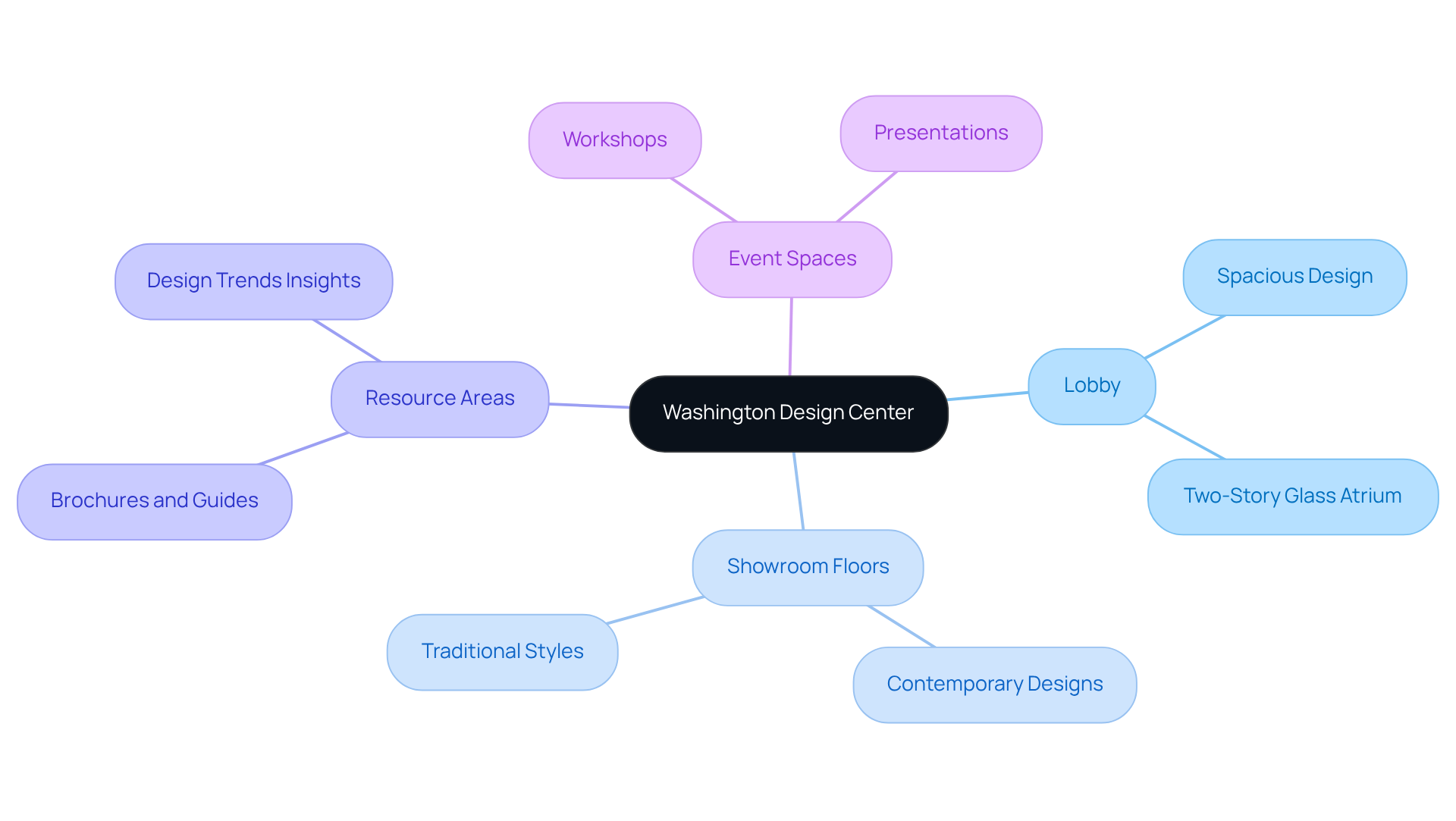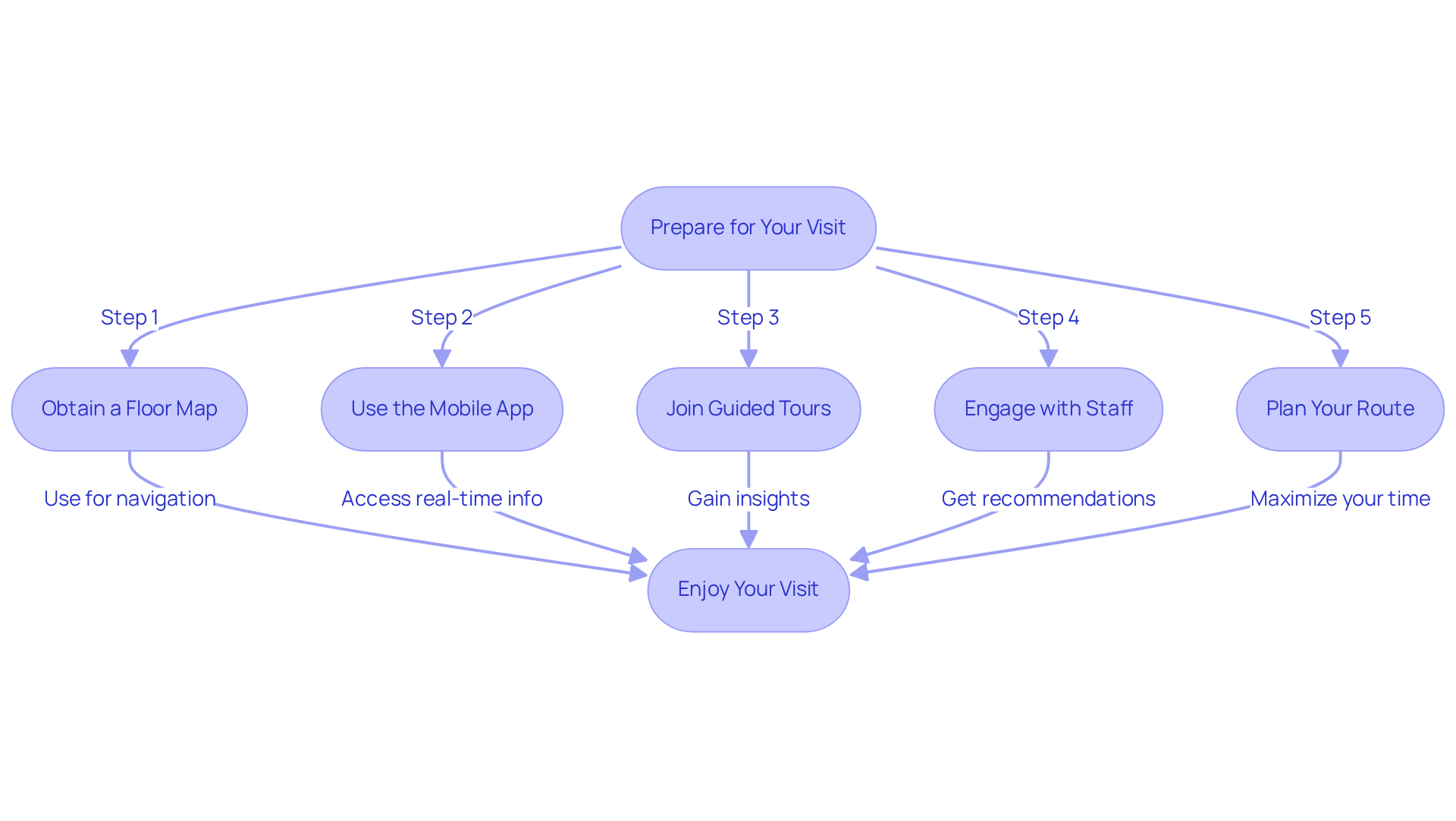Overview
Navigating the Washington Design Center DC can be a daunting task for many. The layout might seem overwhelming, and without a clear plan, visitors may feel lost and frustrated. However, there are effective strategies to alleviate this stress:
- Obtain a floor map.
- Utilize a mobile app.
- Engage with the friendly staff for guidance.
By following these strategies, you can transform your experience into a more enjoyable one. Familiarizing yourself with the center's key areas and planning ahead can significantly enhance your visit. Imagine stepping into the design hub, feeling confident and prepared, ready to explore its offerings. With these simple yet impactful strategies, you can embark on a productive journey through the center, making the most of your time and discovering the inspiration you seek.
Introduction
Navigating the Washington Design Center DC can feel like stepping into a labyrinth of creativity, with its vast multi-level layout designed to inspire and inform. For many, especially design enthusiasts and professionals, the challenge lies in mastering this space, as it holds the potential to unlock a treasure trove of innovative ideas and networking opportunities. Yet, with so many showrooms and resources at one’s fingertips, it’s easy to feel overwhelmed and worry about missing key experiences.
This guide offers expert strategies to navigate the center effectively, transforming what could be an overwhelming visit into a productive and enjoyable exploration. We invite you to share your own experiences as we journey through this vibrant space together.
Understand the Layout and Key Areas of the Washington Design Center
Navigating the Washington Design Center DC, located at 1099 14th Street NW, can be a bit overwhelming for those looking to explore its multi-level facility designed to inspire design exploration. It’s easy to feel lost amidst the creativity and innovation. However, understanding a few key areas can make your visit much more enjoyable and productive.
Upon entering, you’ll find yourself in the spacious lobby, greeted by a dramatic staircase and a stunning two-story glass atrium. This central hub welcomes visitors and sets the tone for your experience. As DC Mayor Muriel Bowser beautifully put it, 'Only one place where you can explore the White House during the day and then go to Ben’s Chili Bowl at night.' This highlights not just the unique experiences available in the city but also the vibrant atmosphere of the Washington Design Center DC.
The center features several showroom floors, each dedicated to different brands and product types. It’s essential to familiarize yourself with the layout; for example, the second floor may highlight contemporary designs, while the third floor showcases traditional styles. Anhelina Pronko emphasizes the importance of synthesizing UX research to [enhance user experiences](https://blog.rno1.com/10-essential-ux-design-positions-for-tech-startup-success), reminding us that understanding this layout is crucial to making the most of your visit.
You’ll also find designated resource areas offering brochures, design guides, and other helpful materials, typically located near elevators or main staircases. These resources can provide valuable insights into the latest [design trends and innovations](https://blog.uxtweak.com/ux-quotes), helping you stay informed.
Don’t forget to keep an eye out for event spaces that may host workshops or presentations during your stay. These events can offer valuable insights and networking opportunities, enriching your experience. With nearly , the Creative Hub plays a pivotal role in the city’s vibrant design community.
By grasping these essential aspects, you can organize your trip more efficiently and ensure that you make the most of your time at the Washington Design Center DC. Remember, every visit is an opportunity to learn and connect, so embrace the journey ahead.

Utilize Effective Navigation Strategies and Tools
Navigating the Washington Design Center DC can sometimes feel daunting, especially for those unfamiliar with its layout. This can lead to feelings of frustration or anxiety, as you may worry about missing key showrooms or events. However, there are several strategies and tools that can help you feel more at ease and ensure a productive visit.
- Consider obtaining a floor map. Upon arrival, you can easily acquire one from the information desk or download it from the Washington Architecture Hub's website. This visual aid will not only help you understand the layout but also assist you in locating with confidence.
- If available, utilize the Design Center's mobile app. This tool can provide real-time updates on events, showroom availability, and special promotions. Given that 32% of U.S. car users employed online-based navigation services in 2022, mobile applications can significantly enhance your experience by offering timely information at your fingertips.
- Participating in guided tours can also be incredibly beneficial. These tours offer valuable insights into the design process and highlight key showrooms that align with your interests, making your journey more meaningful.
- Don’t hesitate to engage with staff members for directions or recommendations. Their expertise can guide you to the best resources tailored to your needs, ensuring you feel supported throughout your visit.
- Lastly, planning your route before your visit can make a world of difference. By identifying the showrooms you wish to explore and mapping out your journey, you can maximize your time and ensure you don’t miss any important stops.
By embracing these strategies and tools, you can navigate the Washington Design Center DC, the architectural hub in the capital, with assurance and effectiveness. Additionally, consider seeking insights from design professionals on effective navigation tools to further enhance your experience. Remember, you are not alone in this journey; many have walked this path before you, and with the right preparation, you can make the most of your visit.

Troubleshoot Common Navigation Issues and Find Resources
Navigating the Washington Architecture Hub can indeed be challenging, even when you’ve planned thoroughly. Let’s explore some common issues you might face, along with supportive strategies to help you through:
- Showroom Closures: It can be disheartening to find showrooms closed for private events or renovations. To avoid any disappointment, I recommend checking the design hub's website or giving them a call beforehand to confirm availability. Remember, since COVID-19, 88% of consumers have heightened expectations for businesses' digital capabilities, making it essential to stay informed.
- Getting Lost: If you ever feel disoriented, take a moment to look for directional signage or don’t hesitate to approach a staff member for assistance. They are there to help and can quickly guide you to your desired location. It’s fascinating to note that users form an opinion about a website in just 0.05 seconds, underscoring the importance of clear navigation.
- Parking Difficulties: Finding a spot in the parking garage can be a race against time as it fills up quickly. If you’re having trouble, consider nearby public transportation options or plan to arrive early to secure a parking space. With 39% of , a little planning can go a long way in avoiding delays.
- Event Conflicts: Busy events often lead to crowded areas, which can be overwhelming. If possible, try to plan your visit during off-peak hours or review the event schedule in advance to avoid congestion. As one event planner wisely noted, "Managing conflicts during busy events requires proactive communication and flexibility."
- Resource Accessibility: When searching for specific design resources or materials, make sure to check the designated resource areas. If you can’t find what you need, please don’t hesitate to ask the staff for recommendations on where to locate additional resources. Case studies have shown that effective resource management can significantly enhance user experience.
By proactively addressing these common navigation challenges, you can enhance your experience and truly make the most of your visit to the Washington Design Center.

Conclusion
Navigating the Washington Design Center DC can feel overwhelming, but it is truly an exciting opportunity to delve into a hub of creativity and design. Many visitors may initially find the experience daunting, yet with the right strategies and insights, it can transform into a productive and enjoyable journey. Understanding the layout and key areas, utilizing effective navigation tools, and troubleshooting common issues are essential steps to enhance your visit.
It's important to familiarize yourself with the center's layout, from the stunning lobby to the various showroom floors, as well as the resources and event spaces available. By acquiring a floor map, using the mobile app, participating in guided tours, and engaging with the knowledgeable staff, you can navigate with confidence. Addressing common challenges, such as showroom closures and parking difficulties, can further enhance your overall experience.
Ultimately, the Washington Design Center DC is not just a place to view design; it is a vibrant community that encourages exploration and connection. By embracing the strategies outlined, you are empowered to make the most of your time, discovering new ideas and fostering meaningful relationships within the design world. Whether you are a seasoned professional or a curious newcomer, each visit is an opportunity for inspiration and growth in the ever-evolving field of design.
Frequently Asked Questions
Where is the Washington Design Center located?
The Washington Design Center is located at 1099 14th Street NW, Washington, DC.
What can visitors expect upon entering the Washington Design Center?
Visitors will be greeted by a spacious lobby featuring a dramatic staircase and a stunning two-story glass atrium, which sets the tone for the experience.
How is the layout of the Washington Design Center organized?
The center features several showroom floors, each dedicated to different brands and product types. For instance, the second floor may focus on contemporary designs, while the third floor showcases traditional styles.
Are there resources available for visitors at the Washington Design Center?
Yes, there are designated resource areas offering brochures, design guides, and other helpful materials, typically located near elevators or main staircases.
What types of events can visitors find at the Washington Design Center?
The center hosts workshops and presentations in designated event spaces, providing valuable insights and networking opportunities.
Why is understanding the layout of the Washington Design Center important?
Familiarizing yourself with the layout is crucial for making the most of your visit, as it helps you navigate the different design styles and resources available.
What role does the Washington Design Center play in the design community?
The Washington Design Center is a pivotal part of the city’s vibrant design community, with nearly 26 million visitors expected in 2023.




